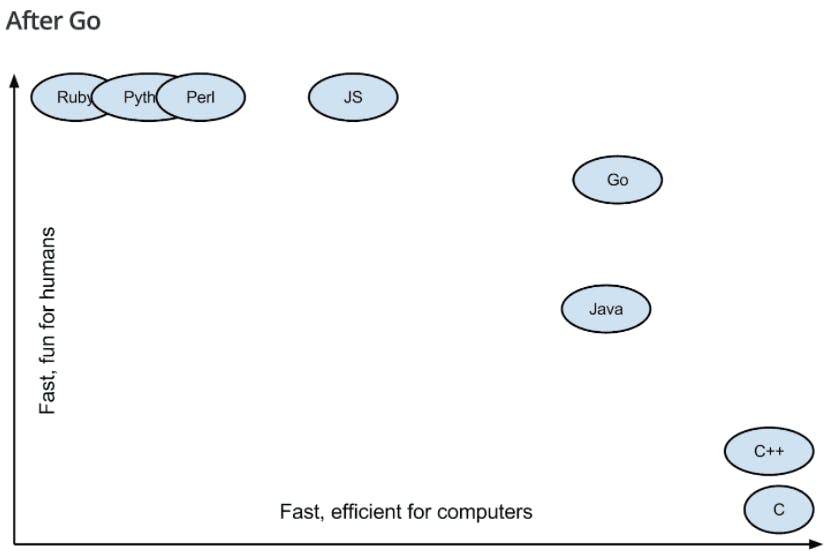
Go (abbreviation of Golang) is a statically typed, compiled programming language initially released in 2009. It was designed at Google by taking inspiration from the productivity and relative simplicity of Python. It's a general purpose language and has been used to write many intensive/high-demand applications, for example, docker & kubernetes.
One of the applications many consider Go for is a web server, we're going to discuss whether Go is a good candidate for this by examining some of its strengths:
Simplicity
Consider the following code:
package main
import (
"fmt"
"log"
"net/http"
)
func handler(w http.ResponseWriter, r *http.Request) {
fmt.Fprintf(w, "Welcome, %s", r.URL.Path[1:])
}
func main() {
http.HandleFunc("/", handler)
log.Fatal(http.ListenAndServe(":8080", nil))
}
The package main signifies that this package contains an executable main() function. This is a special function & is the entry point of the program. Go will automatically call main() & every executable program must contain a single main package and main() function.
This main() makes a call to http.HandleFunc, which tells the http package to handle all requests to the root "/" with the handler function.
It then calls http.ListenAndServe(":8080", nil), :8080 being the port that the server will listen on. The nil tells the package to use the default mux Handler (don't worry about this for now).
This function will now block the program until terminated.
Our handler function has a signature (input parameters & return values) that is required by all http handlers.
The first input parameter is of type http.ResponseWriter, this (as implied by the name) writes to the response issued by the server. Whenever we write to this we are effectively sending data to the client.
The second input parameter is of type http.Request, this is the data structure of the HTTP request received from the client. r.url.Path[1:] creates a sub-slice of the request's URL path from the 1st character onwards (it drops the leading /).
Run this program (go run main.go) and access the following URL:
You should see printed to the screen:
Welcome, reader
Efficiency
When talking about efficiency of a programming language, there are two key things to consider, the rate at which a set of engineers can produce a program & the raw speed of the program itself.
The following graph depicts how Golang is a fine balance of the two (against other languages).

Concurrency
Go uses goroutines for its concurrency. Internally, these are lightweight threads managed by the Go runtime. We can think of them as concurrent functions that run while the rest of the program continues.
Consider this simple example:
package main
import (
"fmt"
"time"
)
func doWork() {
fmt.Println("work complete")
}
func main() {
go doWork()
time.Sleep(1 * time.Second)
fmt.Println("main function finished")
}
go is the keyword that fires off a goroutine with the given function doWork. In a separate thread this writes to the console. Meanwhile the main() function carries on with its execution (albeit blocked due to the time.Sleep). The time.Sleep call is needed as otherwise the main() finishes its execution and all goroutines are cancelled.
There are occasions when one needs to share/mutate data across goroutines. Go employs the primitives known by other languages (mutexes) for handling this but it also has its own unique mechanism: channels. The problem channels aims to solve is data flow, they do this by allowing communication directly between goroutines. I'm not going to go into this now, I'd suggest tour.golang.org/concurrency/2 if interested.
A prime example of goroutines being used is Go's http server, a goroutine handles each http request.
My Thoughts
The first language I used in a professional capacity was php so I found myself comparing the two when I picked up Go after seeing the traction it was gaining in 2018. Building a web server in php there are a myriad of frameworks to choose between, each of them with their own abstractions that conceal underlying functionality.
In contrast, when I began to explore Go I instantly fell in love with how honest it was. Frameworks aren't encouraged, the core packages of Go give you plenty to work with. Getting to the nitty gritty implementations is only ever a click or two away, not to mention how readable it is.
Go quickly became my favourite language to work with and I'd recommend it to anyone looking to expand their toolkit. If you're hoping to get a job using Go I'd suggest searching for job openings in your area before committing. While adoption is on the rise, junior Go roles were elusive for me (London, UK) but your mileage may vary :)
Where to start?
The Go tour is a great place to start. Once you've got the fundamentals down I'd suggest putting them to practice with a small project of your own. It doesn't have to be anything groundbreaking, just enough to keep you engaged. It's important to see & interact with your results.

